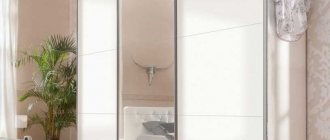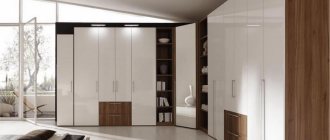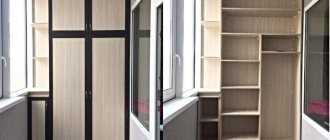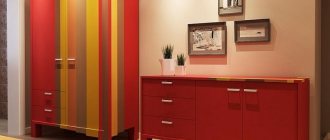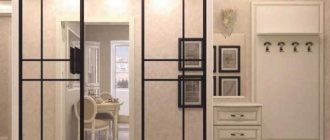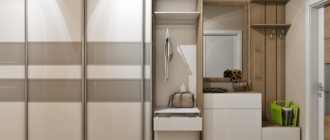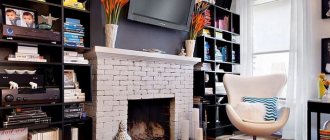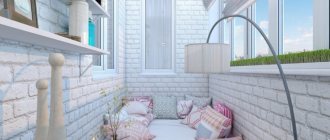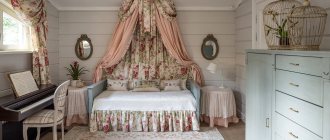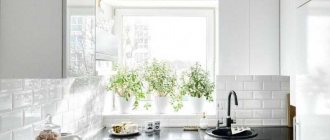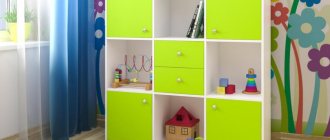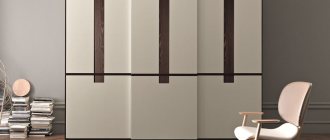Purpose
Modern furniture for residential premises is very diverse in its purpose, design, size, shape and internal content. And each family selects its own set of pieces of furniture based on its own preferences. But almost every apartment has a small or large wardrobe. It is also called wardrobe or dress. Such furniture replaced bulky chests, which were of little functionality, and is used to organize storage issues for a person’s personal wardrobe.
An original design wall with a wardrobe in the Provence style looks very attractive, allows you to place things and bring an atmosphere of comfort to your home. If you think carefully about the “filling” of your wardrobe, it will fit clothes, shoes, bags, belts, and jewelry. Many people even store sports equipment, ironing boards or bedding inside such structures.
The history and evolution of the wardrobe
Modern wardrobe modules have gone through a long evolution. The ancestor of the wardrobe is the chest. Until the end of the 15th century, a wooden chest with handles and a lid attached to forged hinges was the main piece of furniture. Not only were clothes stored in the chests, they were also used as a chair and as a sleeping place. At the end of the 15th century, humanity came up with the brilliant idea to install the chest in a vertical position.
From that very moment, the real history of the development of a popular piece of furniture began. The design was supplemented with shelves and drawers. The design of the closet began to change rapidly; the once rough chest made of boards was transformed into a pompous product made of expensive wood. The walls began to be decorated with carved elements, openwork metal overlays, inlays, and paintings.
In the 18th century, a gradation of furniture products appeared, and cabinets began to be classified according to their purpose. The concepts of a cabinet-office, a cabinet-cabinet for business papers, and a wardrobe appeared.
Prices for wardrobes
Furniture manufacturers and sellers offer cabinets of various price categories - economy class, middle class, elite class. The price of the product depends on the choice of material, design and the presence of decorative elements. In the economy class there is practically no furniture made of solid wood or decorated with natural veneer. Decorative elements such as stained glass or decorated glass are a sign of high-quality luxury furniture. Furniture fittings also play an important role in determining the price of a cabinet. The durability and appearance of the wardrobe depends on the quality of the fittings (hinges, handles, rollers, etc.), but high-quality fittings can significantly increase the cost of the wardrobe.
Main areas
To make the furniture ergonomic, it is worth highlighting several zones in the wardrobe.
| Zones | Options | Filling |
| Lower | Up to 0.8 m from the floor | Here you can store rare items, if there are drawers - underwear, socks. Also, if it is not possible to store shoes in the hallway, the lower area of the wardrobe can be reserved for this purpose. In this case, each pair of shoes should be thoroughly washed, dried, and put in a box. |
| Average | 0.8-1.8 m from the floor | Things that people constantly need are stored here. Place shelves in the middle zone for various kinds of things. If they are part of the structure, that is, stationary, the cabinet will be able to withstand more significant loads. If the shelves are removable, then it is better to store things that are not too heavy on them. The optimal width of the shelves is 60 cm, and the distance between them is 40-45 cm. |
| Upper | Above 1.9 m | This is a good place to store hats, umbrellas, bags, scarves and gloves. That is, light things that a person needs from time to time. |
“Standard” models have a fairly simple content, while products in the “elite” category can be equipped with expensive storage systems, drawers for unified clothing, so more zones can be allocated in them.
What is a wardrobe
Such a piece of furniture is a necessary detail of the interior of a living room or bedroom, in which clothes, shoes and other things of the apartment owner and other household members are stored. In the traditional presentation, a wardrobe is furniture with two or three doors, equipped with drawers and a special rod for subsequent hanging of hangers with wardrobe items. Often, a large mirror is attached to one of the doors, in which a person can see his reflection after putting on the chosen outfit.
REFERENCE! Initially, the piece of furniture was a special room and was called a wardrobe. Only in the 19th century did the interior of the room begin to resemble a modern wardrobe with special shelves and rods.
Modern wardrobes are made in various stylistic solutions and differ in size. There are models:
- with opening doors;
- “coupe” (sliding doors);
- with folding doors.
Also in showrooms you can find models with large dimensions that have many sections for storing things. Small single-leaf products, popularly called “pencil cases,” are usually installed in small rooms. They are designed to contain a small volume of items intended for daily wear.
Large wardrobes are provided for spacious rooms and storage of a much larger number of wardrobe items, shoes and hats. They are equipped with shelves, drawers, and often have holders for belts and ties.
Required elements
Each wardrobe has mandatory and additional elements. The first include shelves placed one above the other. They are convenient for storing small items for frequent use (T-shirts, tank tops, trousers, sportswear). Also a mandatory element of such furniture is an area with a horizontal crossbar with hangers. They store outerwear and dresses.
Expensive models may have specific storage systems for a certain type of clothing: sportswear, shirts, trousers, jackets, and so on.
Style and form
Modern designers use wardrobes to decorate bedrooms in different stylistic directions. The most relevant cabinets are in the style:
- classic style - for this type of decor of residential premises it is worth choosing huge, massive and solid cabinets in a classic style with an unusual finish, made of solid wood. Models should be decorated with large inlays, stained glass inserts, paintings, and textured patterns on the front doors. Such decor allows you to make your wardrobe chic, representative, and stylish. It looks especially stylish when things are folded in a white wardrobe, an option in wenge or mahogany in a classic interior;
- in Provence style - for an interior in Provence style you will need a wardrobe made of natural wood with curly legs and a surface with an antique effect, hinged doors. The color scheme of the models should be light, natural in tone;
- in country style - choose wooden models. An excellent option would be pine, which gives a natural smell. The color of the furniture should not be too dark, but not too light, in order to successfully complement the interior in a rustic style;
- in the loft style - a wardrobe with a laconic look, hidden fittings, by the way, would be perfect in a loft living room.
Materials
There is a wide variety of materials from which a wardrobe can be made. These are MDF and chipboard, which are environmentally friendly materials, so you don’t have to worry about your health when storing things in them. The cost is low, but cabinets made from these materials have long proven their reliability and good quality.
Cabinets made from solid wood are much more expensive. Such furniture will make your interior exclusive and practical. The most common materials are oak, pine, and beech wood. Vertical mirrors and light shades visually reduce the massiveness of these cabinets; they will fit perfectly into the classic bedroom design.
The modern trend has become the production of objects made of plastic with imitation wood or metal. A corner wardrobe made of plastic can make the interior of your apartment quite original.
One of the innovations is the production of interior items from acrylic glass. Glass is a rather fragile material, so not everyone has the opportunity to purchase just such a cabinet. It will look advantageous in large and bright bedrooms.
Selection rules
If the layout of the room includes a niche, an excellent solution would be to organize a wardrobe inside it with sliding doors. The dimensions of the compartment can be very varied: height is 1.5-2.4 m, depth 0.4-0.6 m, width 1-2 m. Models of hinged wardrobes are relevant for spacious rooms, because when swinging the door open it requires sufficient space . You can’t put such a wardrobe in a narrow corridor or a tiny bedroom.
Wooden furniture looks the best in conservative classics. And what does it smell like? For example, pine and other species smell very good. To save money without compromising the aesthetics of the furniture, you can combine chipboard with MDF to make a wardrobe. The following photo shows such a model with a large facade.
What types of cabinets are there by type of location?
Modern manufacturers produce three main types of cabinets.
Freestanding
The furniture is a free-standing structure with 4 panels and a supporting frame. Typically, such models are installed along the wall. Such options can be placed in the hall, hallway or bedroom. There are options with sliding doors or hinged doors. They also produce designs without doors for the hallway.
Built-in
Such designs allow maximum use of free space. The cabinet is built into a wall or opening. Typically, such models have many shelves and sliding doors. Stationary options of this type save great space due to sliding structures and look stylish in any interior. The boundaries of the furniture are three walls, a ceiling and a floor.
Partially built-in
The main feature of this design is that one of the sides does not have supporting parts. That is, the cabinet is partially built into the wall. Such options are most often mounted along a corner wall or made adjacent between two zones. This design will be indispensable in small rooms where there is very little free space.
